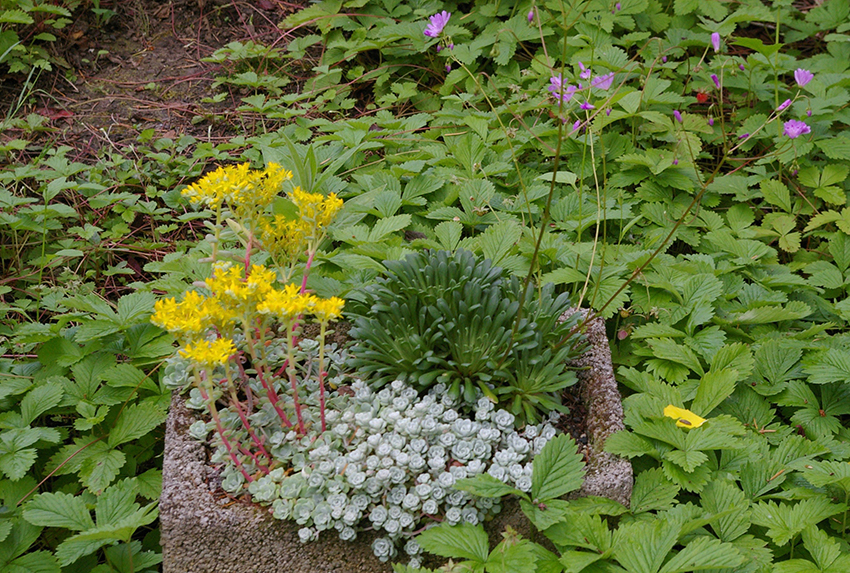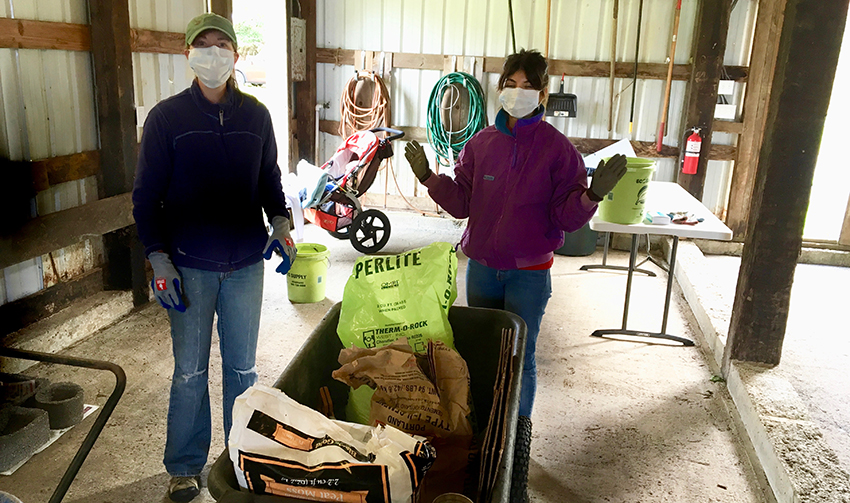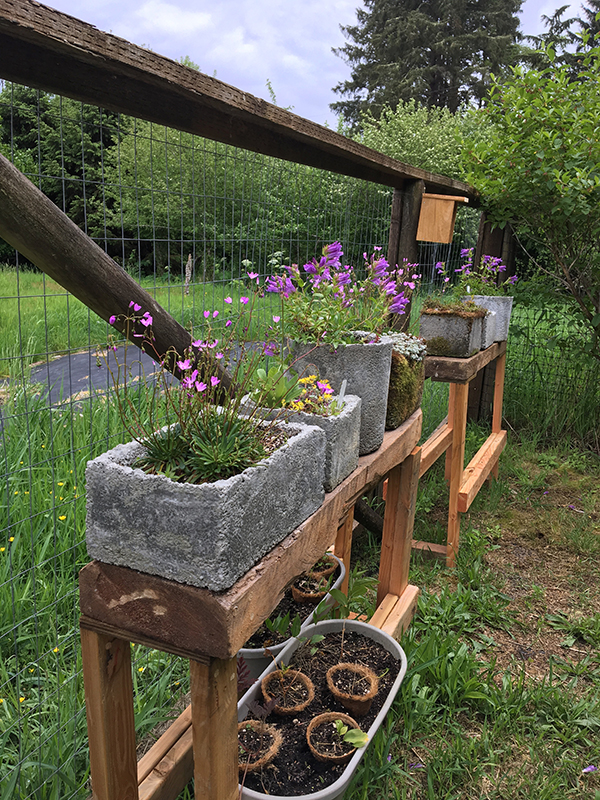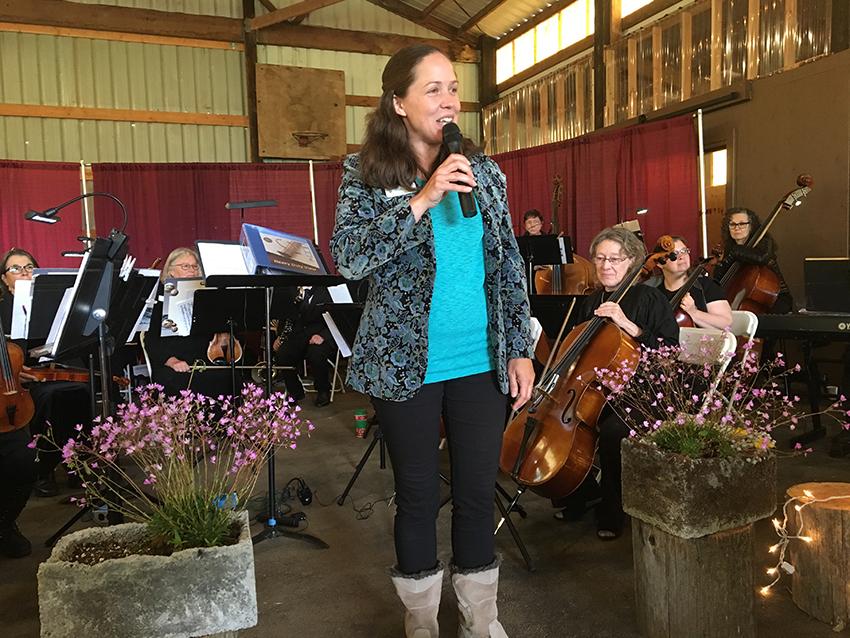Jeff Roehm is an active NCLC vounteer who splits his time between Portland and Manzanita. We wrap up our Summer 2019 focus on the 15th anniversary of Circle Creek Conservation Center with this essay from Jeff.
One day in early spring just over three years ago, I was sitting on my deck in Portland looking around at all the wildflowers that were starting to push through the dirt, welcoming me to the real beginning of the new year. Over time the garden back here had gradually morphed into a natural setting. Just out of curiosity I’d added them up; 49 separate species of native plants. That’s a lot of plants. In my defense, it could be cats.
I looked over to a spot by the fence under a large mock orange that was just leafing out. There sat an old pot that held two wildflowers native to the Oregon Coast. One was called Columbia lewisia (Lewisia columbiana), so named even though William Clark, not Meriwether Lewis, was the first to describe it in 1806. The other was broadleaf stonecrop, with a scientific name—Sedum spathulifolium—guaranteed to frighten aspiring botanists! They were listed as locally common, but if you actually wanted to see them in nature you’d have to hike to the top of Saddle Mountain. They were doing fine in my backyard, but nobody was going to see them over by my fence either.

Lewisia columbiana atop Saddle Mountain
That’s when I decided to do something I’d been thinking about for some time. I picked up the pot, carried it out to my car, and headed to the beach. The new home for this pot would be a forgotten nursery area out behind the stewardship shed at NCLC’s Circle Creek Conservation Center. I planned to put it over on the far side by the fence and out of the way, but there would still be a chance that someone besides me could see it. I was thinking that maybe over time there might be some more such plants, and maybe we could dress up this place with some natural color. The possibilities were foggy at best, but limitless.
So there sat my pot for the rest of that year and on into the next spring, blooming, then fading, but this time being visited by the regular inhabitants of the nursery: the NCLC staff and volunteers. After all, this pot had an interesting story to tell. I think it began in about 1992. I was at a native plant sale put on by the Leach Botanical Garden when the unthinkable happened: I won the door prize! There it was, a hypertufa trough filled with native plants, including an incredibly rare Kalmiopsis leachiana, the garden’s signature plant. Sitting next to it, smiling, was the Leach head gardener, Scott Hoelschner. I was so obviously the perfect winner of this prize and proved it with my first question: “How did you make this?” The answer from Scotty: “Come over this Wednesday, and I’ll show you how.” What followed was a fun training session followed by a litany of “containers” for everything I could think of that I wanted to grow. Over the next five years or so I made at least 20 hypertufa pots, but who’s counting. This pot, now sitting by the fence at Circle Creek, was by now almost 25 years old and had been sitting outside in the elements its entire life. The flowers it held had been in there for 12 years.

In my Portland garden, 2011
Finally came the inevitable question from Melissa Reich, our fearless leader of the stewardship people: “Do you think you could teach us how to make these pots?” I was stunned! This is something I had never, ever thought of doing. So I gave my usual answer when Melissa asks me to do something: “Sure.” Then I started to think, I haven’t made one of these in maybe 20 years. Do I even remember how? So after a trial run with Melissa and her sidekick Amy Hutmacher to discover what I’d forgotten, we were off and running: first a workshop for local native plant enthusiasts, then one for NCLC staff, then again this spring as an “On The Land” event for the public. If you count success by numbers, we met and exceeded our goal with this last one. Lynette Villagomez—who had scheduled it, promoted it, signed up participants, and then signed up for it herself—never got to make a pot. Instead she was busy helping me with the unexpected crowd that had shown up on the day of the event. We’ve now made a lot of pots, I’ve learned a lot in the process, and most of all we’ve had lots of fun. Really, we have.

Amy and Lynette at our second workshop
In the meantime, this past year Pat Wollner has led a complete rehab of that nursery, causing my old pot and by now several others to spend a season out of harm’s way in her backyard. Finally this year those pots are back in our beautiful nursery, now with lots of company. The change has been organic, which is to say, what has happened and is still happening is natural, maybe inevitable. We needed somewhere to display these, out of the way but easy to see. Pat’s brother Doug built the perfect tables which are now along the fence filled with containers and flowers. The rules evolve, but for sure these will only be plants that grow naturally on NCLC land.

The nursery evolves with happy plants
And then there’s this: to me, the perfect symbol that the NCLC native plant nursery is the home this old pot was always meant to have, the absolutely perfect home. But then, I can get pretty emotional, or maybe just sentimental. As part of the celebration of Circle Creek’s 15th year, there have been lots of events scheduled there through the summer. One of these was a June Concert in the Barn put on by the North Coast Chamber Orchestra, an ensemble of local musicians. This was a perfect event, made more perfect still by the usual magic hand of the NCLC staff. So when Lynette asked me the next inevitable question, “Could we use some of your flowers for the concert?” Out popped the usual answer: “Sure.”
Did I mention that the Columbia lewisia and broadleaf stonecrop have been very happy in their new home? Wildflowers are niche creatures. All they want is to be in the perfect combination of soil, water, climate, and love, and they’ll be glorious. If not, they’ll never look quite right and their lives will be short. So as fate would have it, my now-27-year-old pot, covered with moss, with its 15-year-old flowers in full bloom made its way to the podium along with Amy’s test-pot from that first trial workshop. NCLC Executive Director Katie Voelke welcomed everyone. The first violin squeezed past Amy’s pot to tune the players. The conductor came on, gave his bow and then the downbeat. Beautiful music filled the barn.
Everything about this evening was perfect!

Katie Voelke kicking off the Concert in the Barn
Comments